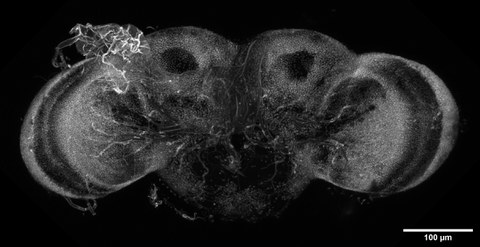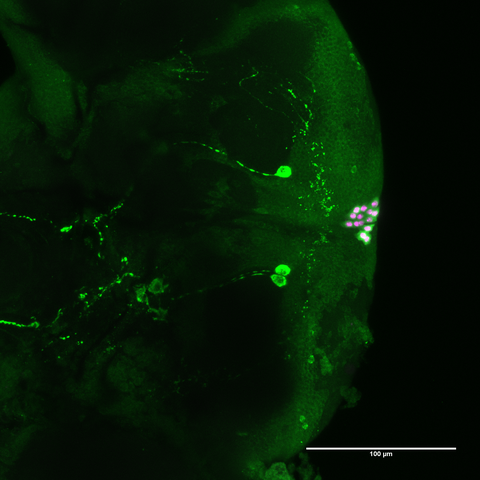Research
Ethical regulations, experimental shortcomings and the complexity of vertebrate models are challenging obstacles to study the response of insulin signaling (IS) at multiple levels. The high conservation of the IS circuit positions insects as an inexpensive, handy tool to spearhead pioneering studies. Insects produce Insulin like peptides (Ilp) in response to dietary cues and the organization of the cellular Insulin-like signaling cascade (IlS) is similar to vertebrate counterparts (Yoshihiro et al. 2018). Drosophila melanogaster is a prime target to study metabolism, especially diet-dependent IS. Wild fruit flies feed on rotting fruits i.e. a composite diet with a microbial and a plant proportion. Such food sources are patchy in nature and as alternative fuel adults feed from other carbohydrates sources such as nectar (Hulbert et al. 2014). In addition, Drosophila are cold-blooded animals and need to acclimatize fast. Hence, the feeding behavior of flies depends on given temperatures and their metabolism adjusts quickly to provide needed energy (Brankatschk et al. 2018; Knittelfelder et al. 2020).
Wild fruit flies feed on rotting fruits i.e. a composite diet with a microbial and a plant proportion. As such, food sources are erratic in nature adult fruit flies also feed from alternative carbohydrate sources, such as pollen (Watanabe et al. 2019). From the metabolic point of view, dietary changes result obviously in a dramatic qualitative and quantitative variation of absorbed nutritional compounds. In addition, diet-induced alterations of the intestinal microbial environment and the availability of microbial products can change the activity of metabolic circuits (Wong et al. 2014). Further, Drosophila are cold-blooded animals and need to acclimatize fast. Adult flies endure subzero cold for a limited time and survive short periods of heat stress close to 40°C (Hoffmann et al. 2003). At low temperatures adult flies resort to seek yeast-free plant-derived food (Knittelfelder et al. 2020; Brankatschk et al. 2018). High temperatures force fruit flies to accelerate their metabolism, and feeding on yeast is essential for flies to maintain high IS levels (Brankatschk et al. 2018). However, passing 29°C Drosophila abandon the predicted turnover curve predicted by the Arrhenius equation (Bliss 1926) and animals are increasingly limited in their chance of survival. Taken together, to understand ‘nutritional acclimation’ of insects it is of paramount importance to study the regulation of metabolic circuits including both variables - temperature and food. The highly conserved insulin-signaling cascade regulates anabolic and catabolic turnover rates and therefore, represents a suitable target of interest.
The IS circuit in fruit flies is discussed as an evolutionary ancestor of its vertebrate pendant with insulin and IGF signaling merged into one pathway. dIlp expression is regulated in direct response to nutritional cues and the caloric load and the protein/sugar ratio of the diet are main regulating factors (Semaniuk et al. 2018). The high sequence preservation and functional redundancy of dIlps can explain the normal viability, fertility and aging displayed by individual dIlp allele mutants kept on optimized food, such as normal food, that contains plant and yeast material (Broughton et al. 2008; Kannan and Fridell 2013). Drosophila produce seven different Insulin like peptides (Ilps) in response to dietary cues (Grönke et al. 2010). The structure and function of dIlps and the putative precursor protein are similar to human insulin and insulin-like growth factor (IGF) peptides or pre-pro-insulin ,respectively, implying an analogous organization of the final secreted peptide (Brogiolo et al. 2001; Grönke et al. 2010; Rulifson et al. 2002). Some dIlps play exclusive developmental roles, such as dIlp1(Liu et al. 2016; Slaidina et al. 2009; Liao et al. 2020) and 4 (Brogiolo et al. 2001), and their production is timely restricted. Adult flies mainly express dIlp2,3,5,6 and 7. dIlp2,3 and 5 -produced by neuronal insulin-producing cells (IPCs)-are secreted into circulation (Rulifson et al. 2002; Nässel et al. 2013)and resemble the functional role of vertebrate Beta-cell derived insulin (Rulifson et al. 2002). In contrast, dIlp6 mRNA is detected in fat body cells and its production is upregulated in starving conditions (Slaidina et al. 2009). DIilp7 is produced by specialized dIlp7-neurons (D7Ns) and is the only Dilp peptide showing structural conservation across species (Grönke et al. 2010; Krieger et al. 2004; Riehle et al. 2006). DIlp7 has been proposed to be a relaxin-like peptide due to its function in female egg laying (Zhang et al. 2009); however this Relaxin function has not been clearly established.
On the receiving site, cells express Insulin binding proteins. Best understood is the Insulin receptor (InR), a membrane bound protein dimer with extracellular alpha and intracellular beta domains. Individual monomers can vary in their structural build up and therefore, the functional InR can operate as a homo- or heterodimer. To date, most results are based on InR homodimers (alpha1/beta1) and it remains unclear if different InR configurations modulate the metabolic readout. In addition, several Dilp binding proteins are known, such as ‘Decoy of InR’ (SDR, Okamoto et al. 2013) and the ‘imaginal morphogenesis protein Late-2’ (IMPL-2, Honegger et al. 2008). There are also two GPCR proteins suggested to bind dIlp peptides, however, biological evidence in support is limited (Veenstra et al. 2012). The vertebrate orthologue of IMPL-2 is the IGF binding protein IGFBP-7. Like IMPL-2, many cell types including neurons express IGFBP-7. The receptor is targeted by IGF-1, IGF-2 and Insulin (Oh et al. 1996; Ruan et al. 2016). IGFBPs are considered scavenger receptors to deactivate hormones or are described as complexing factors that stabilize signaling cues in circulation (Allard and Duan 2018). Alike IGFBP-7, IMPL-2 is able to bind multiple ligands namely Dilp2 and Dilp5. Both Dilps have partially overlapping roles (Post et al. 2018) and are reported InR ligands.
We are interested to elucidate the role of temperature, lipids in calorie-rich diets and microbes for the development and adult life of Drosophila. To reach our goals we combine a battery of different methods including behavior studies, genetics and lipid-focused biochemistry, and microscopy. Our goal is identify and chart the response of metabolic circuits to signal lipid-cues encoded in the food.


